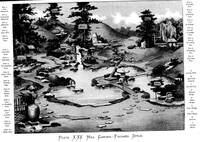A Hill Garden may be in any of the three styles of elaboration, finished, intermediary, or rough. Plate XXV illustrates the model for an ordinary Hill Garden of the finished style, The positions of the principal hills, stones, tree clumps, cascade, bridges, and islands are all relatively established by rule and for the purpose of reference are figured on the Plate. Hill 1 forms the central feature of the nearer distance; it represents a mountain of considerable size, and should have broad sweeping sides. It may have a pathway near its base, and a little pavilion on its slope, but in the present illustration a pathway only is indicated. The position of this garden hill must be determined after settling the general distribution of the landscape, for it is important that the lake inlet or cascade should be arranged just in front of it. Hill 2 is employed as a companion to No. 1, to which it should be adjacent; it is somewhat lower and of secondary importance. A cascade and rocks often mark the division between the two. Hill 3 is placed on the opposite side of No. 1, near the base of its broad slope, and somewhat more in the foreground; it is intended to represent a lower hill or spur divided from the principal mountain by a depression. This depression is supposed to be occupied by a hamlet, road, or stream, and it should be planted with a few trees or shrubs of thick foliage, giving the idea of a sheltered and inhabited dale. Hill 4 is a small eminence generally introduced in the near foreground and on the same side of the composition as Hill 2; it should be low, rounded, and covered with detail in the form of stones and shrubs, and must have none of the characteristics of a large or distant mountain. Hill 5 is placed in the remotest part of the garden, visible over the sides of Hills 1 and 2; as it is meant to represent a distant peak in mountain scenery, it should be steep in form and partially hidden below, with little or no detail upon it. (Hill 1. Near Mountain. Hill 2. Companion Mountain. Hill 3. Mountain Spur. Hill 4. Near Hill. Hill 5. Distant Peak. Stone 1. Guardian Stone. Stone 2. Cliff Stone. Stone 3. Worshipping Stone. Stone 4. Perfect View Stone. Stone 5. Waiting Stone. Stone 6. Moon Shadow Stone. Stone 7. Cave, or Kwannon Stone. Stone 8. Seat of Honor Stone. Stone 9. Pedestal Stone. Stone 10. Idling Stone. Tree 1. Principal Tree. Tree 2. View perfecting Tree. Tree 3. Tree of Solitude. Tree 4. Cascade-screening Tree. Tree 5. Tree of the Setting Sun. Tree 6. Distancing Pine. Tree 7. Stretching Pine. A. Garden Well. B. Snow-view Lantern. C. Garden Gate. D. Boarded Bridge. E. Plank Bridge. F. Stone Bridge. G. Water Basin. H. Lantern. I. Garden Shrine.)

